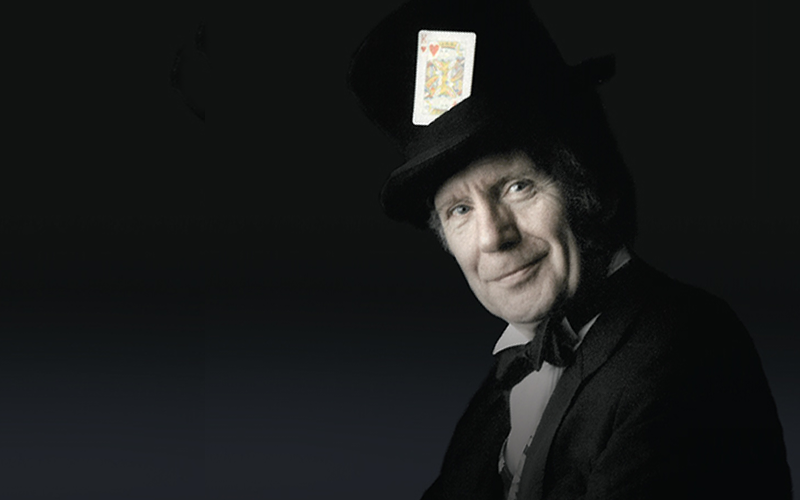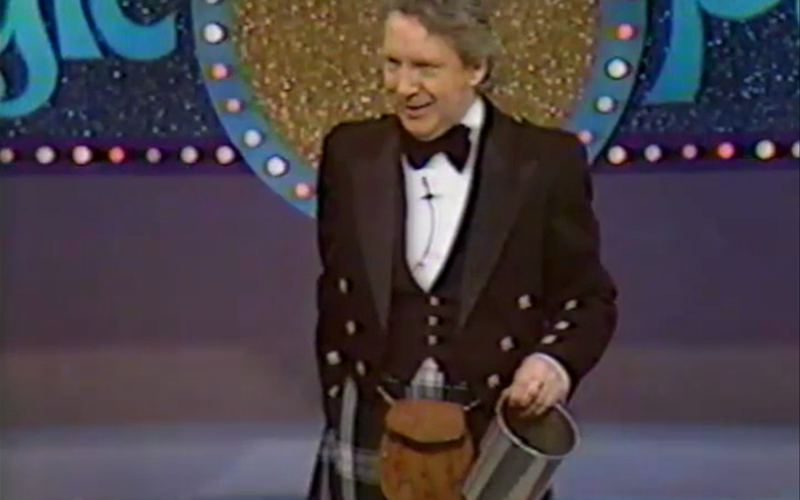Submitted by Jamy Ian Swiss on
I recall getting a phone call one afternoon in the 1990s from Teller, asking if I knew anything about a particular old magic trick. We chatted a few minutes, and then I said, ‘Well, you should probably call the triumvirate.’ At that time, the word needed no further explanation, because he knew I meant that he should—and would indeed—call on Johnny Thompson, Billy McComb, and Jay Marshall. Along with their contemporaries in the United Kingdom—Ali Bongo and Patrick Page—these minds housed much if not most of the magical wisdom of the ages. All of them save one, John Thompson, are gone now.
In a recent book review for the Lyons Den, I mentioned learning a sleight in my youth from an instructional audiotape by Patrick Page—and it got me thinking about Pat. An accomplished professional performer, an author of some twenty publications about magic, an inventor of numerous tricks, and an award-winning magician, Pat Page eventually became a revered and beloved national treasure among the British magic community and beyond.
I first encountered Pat at the 1978 Society of American Magicians convention at the Waldorf Astoria Hotel in New York City (which also marked my first meeting with Dai Vernon, and my first and only witnessing of the Asparagus Valley Cultural Society, progenitor of Penn & Teller). I recall seeing Pat's lecture, which among other things featured an old, but at the time little-known, secret device that he had been utilizing for many years. The effect was a feature of his repertoire as a demonstrator for London’s venerable Davenports Magic, where he worked for a thirteen-year stretch in the midst of his long magic career. At one point in the lecture, he took an entire deck of cards—just the cards, loose in his hands—gave them a little toss, and then suddenly, they vanished into thin air. Just like that. I was astonished. Most of the thousand-seat room was equally stunned, I’m sure. I became a fan for life. And I also became a loyal reader of his column that ran, in the ‘70s and ‘80s, in Pabular, a British journal of close-up magic.
Years later, I would have the immense good fortune to get to know him. Pat was a successful working performer who specialized in comedy stage magic—interestingly, a shared characteristic of all five of the names listed in my opening paragraph. Pat performed classic sleight-of-hand routines accompanied by sharp and funny banter and an outsized, charming and memorable character. Much like his colleague Paul Daniels, Pat rose through the trenches performing in British working-man clubs and would eventually become a revered counselor and professional consultant, just like that select group cited above, to younger stars of magic, including the likes of Derren Brown. After Pat’s death, Brown wrote:
Magicians worth their salt will know that Patrick was a genius of our craft, and a famously generous man. I knew him a little from his consultancy work on some of my projects: he was a brilliantly rude, sharp-witted, sensationally likeable Scot, better at magic and more knowledgeable than any of us. All of us at Objective [Media Group] are devastated by the news. For some time, the sheer force of his personality has kept him going through illness, but now he doesn’t need to fight any more. At the same time, as with any powerfully creative force, he will live on strongly and defiantly through his work and the legacy he leaves. There’s a bit of Patrick every night in Enigma [Brown’s then live touring show], and in countless other performances happening now across the world.
Not unlike Johnny Thompson, Pat also loved close-up magic and he was truly great at it, performing close-up magic professionally until the very last days of his life. One of his favorite conventions was Fechter’s “4F”—an invitation-only annual gathering of hard-core close-up magic aficionados, which takes place in upstate New York. And Pat made it his business to attend every year. The convention, incidentally, continues to honor him today with a memorial lecture presented in his name.
Fortunately for me and my co-producers of Monday Night Magic (New York’s longest-running Off Broadway show, now in our twenty-first season), Pat’s annual attendance at Fechter’s meant that he would come through New York City to visit friends—and he would grace the stage of our weekly show. Watching Pat was always a delight and a revelation. Each time I saw him performing the Miser’s Dream, or the Linking Rings, or his version of finding any named card (“Top, middle, or bottom?”), I would invariably end up asking myself, Why aren’t I just doing these great tricks and nothing else?
Pat had seen it all in his day; he was a genuine trooper and nothing could rattle him. One of our oldest inside and affectionate jokes at Monday Night Magic came from one of the first shows Pat ever did for us—if not his very first appearance. A group of learning disabled young people came to the show that night, and they were enthusiastic and joyful, to the point of being quite vocal and demonstrative at times. One boy, very close to the stage, would happily shout out his pet compliment every time Pat got a laugh or completed a routine: “You good guy!!!” While the interaction was utterly sincere and charming, it was also potentially disruptive and distracting. But Pat not only took it in stride, he was also warmly receptive to his outspoken audience. Later, at the post-show gathering, we all kidded Pat about it, while also expressing our apologies for the challenges it had presented him. But on stage or off, Pat remained a model of grace under fire. He dismissed any concerns in thoroughly good humor, and for many years afterward, whenever Pat was in the house, “You good guy!” would be the running exclamation among all of us.
During his stays in New York, Pat would often stay with my friend and colleague Bill Brunelle and I got the chance to spend a fair amount of downtime with Pat, talking magic, asking questions, ever the student in his presence. I attended one of his lectures in Manhattan decades after that first one at the SAM convention, and it was brilliant from start to finish. Pat could fool any group of magicians over and over again, but never with pretension or ego. He instead presented great magic with passion and joy, invariably teaching entertaining routines, sound principles, and beautiful sleight-of-hand finesses.
My dear and greatly missed friend, magic consultant and historian Charles Reynolds, was also a particularly close friend of Pat’s. It was Charles who relayed to me that Pat had once told him that the greatest thing someone can do for an out-of-town performer friend was to either pick him up or drop him off at the airport—sparing that friend the stress of finding one’s way before or after a long journey.
Years ago I was visiting London and staying at my friend David Owen’s home. The phone rang and my host announced it was Pat calling for me. I had seen Pat during the course of my stay, but that had been some days prior.
“Hi, Pat.”
“When are you leaving?” he asked bluntly. I told him the day.
“What time?” I responded accordingly.
“Right, then,” Pat said. “I’ll pick you up at 1:00 pm on Tuesday,” or whatever the time and day were.
“Well, okay… if you say so. Thanks, Patrick!”
I remember putting the phone down, slowly shaking my head in wonder. There had been no prior discussion, no request on my part. True to form, Pat had simply elected to give me the great gift. And it truly was a great gift.
On the assigned day, he picked me up and drove me to Heathrow, getting lost in and around the airport several times before finding the correct location—thus sparing me all the stress of having to take the time and trouble to figure it out myself while managing my luggage along the way.
I’ll never forget the wee Scotsman with the giant personality, ever overflowing with kindness and good humor. Thanks, Pat.
Three Classics
Pat invariably performed these three routines, among others, on stage at Monday Night Magic. I never tired of them. Of course, while they have become classics for very good reasons, it was Pat’s particular routining, execution and performance that made them so terrific. A few jokes of the era have not aged well, but like with the Rat Pack, I believe one should put the humor in the context of the time, and see and appreciate the performer for all he is worth.
Pat’s inner warmth and connection with the audience is inescapable. There are moments that still make me laugh out loud, or shake my head in amazement at the skill on display. Even if one is familiar with the magic, it’s easy to overlook the fact that Pat’s sleight-of-hand is indeed superb.
Pay attention—and please pay due respect to the art and the artist by expanding the browser to the max, turning up the volume, and setting the smart phone aside for the duration. Watch and enjoy the delights of Patrick Page.
Close-Up Magic
Here’s a fine segment of several original close-up routines, each of which highlights Pat’s distinctive style and vision. And while these are classic plots, there are a few moments where magicians may well do a double take and find themselves pleasantly surprised and fooled by the magic.
Easy Money
Of all of Pat’s creations, this is the most famous among magicians. It is still widely performed today, often mistakenly attributed to Fred Kaps, and also widely marketed in variations by other magicians—many of which are no better than, if not inferior to, the original.
Comedy Magic
And here’s one final set, demonstrating Pat’s ability to get a lot of laughs with minimal props and an abundance of charm, wit and good timing. In Pat’s hands and under real conditions, the Card on Forehead always brought the house down.
Note to magicians
You can obtain Pat’s superb and handsome book Magic Page By Page, which I reviewed in the March 2012 issue of Genii. The book is a true manual for workers and available from a lovely website established by his family, along with a number of other manuscripts and props of Pat’s creation. You can also read a great page of “Pat Facts” that is bound to tell almost any magician something he or she didn’t know about the fabulous range of his talents, interests, and accomplishments.
SEE TAKE TWO INDEX









